-
October 2, 2018 by Total Fire and Safety
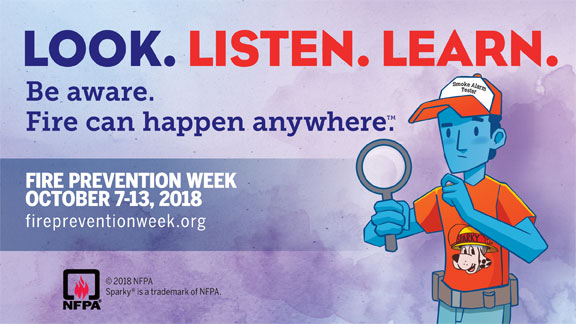
Fire prevention week was instituted in commemoration of the Great Chicago Fire of 1871 which burned from October 8-10, 1871 and took the lives of nearly 300 people. It burned nearly 3.3 square miles of Chicago and left over 100,000 residents homeless.
Forty years after the tragic blaze, the U.S. Fire Marshall used the anniversary to promote fire prevention and fire safety. In 1925, President Calvin Coolidge proclaimed fire prevention week as a national observance and it has become the longest running health observance in the country.
Even though we know more now about fire prevention than ever before and we have better equipment too, the National Fire Prevention Association (NFPA) released a shocking statistic: if you reported a fire in your home, you are more likely to die today than you were a few decades ago. Today’s home fires burn faster, allowing occupants less than two minutes to escape without harm.
Although the messages of Fire Prevention Week primarily focus on home fires, their messages can be applied at any location including businesses, warehouses, and other commercial spaces. Fire prevention week is a time to draw attention to the fire safety practices within your company using the resources provided by fire departments, the NFPA, and companies like Total Fire and Safety.
The following are some initiatives companies can take to observe Fire Prevention Week:
This year, fire prevention week runs October 7-13. The theme is Look. Listen. Learn. Be aware- Fire can happen anywhere. This year’s campaign focuses on basic but essential ways to escape your home fire safely with three simple steps:
- Look for places a fire could begin. Identify potential fire hazards in your workplace and remove them.
- Listen for the sound of the alarm. As soon as the alarm sounds, make your way out of the building at a safe distance from the fire.
- Learn two ways out of every room. Make sure all exits leading outside are free of clutter, unlocked and have emergency lights if necessary.
Fire prevention week is also commemorated at fire stations all over the area with special open houses and related programs. Here’s a roundup of some of the events in the Total Fire & Safety service area. For more information, see the website for each individual fire department.
If we can ever be of help to you during fire prevention week or any other time during the year, call Total Fire and Safety to ensure your business in in NFPA compliance with all of your commercial fire protection at 630-960-5060.
Saturday, Oct. 6
- Tinley Park Fire Department: 17355 68th Court, Tinley Park, 9 a.m. – 1 p.m.
- Schaumburg Fire Department: 950 W. Schaumburg Road, Schaumburg, 11 a.m. – 2p.m.
- Clarendon Hills Fire Department: 316 Park Ave., Clarendon Hills, 11 a.m. – 2 p.m.
- Minooka Fire Department: 7901 E. Minooka Road, Minooka, 11 a.m. – 2 p.m.
- Hazel Crest Fire Department: 2903 W. 175th St., Hazel Crest, 9 a.m. – 12 p.m.
- Bensenville Fire Protection District: 500 S. York Road, Bensenville, 12 – 3 p.m.
- Darien-Woodridge Fire Department: 7550 Lyman Ave., Darien, 10 a.m. – 1 p.m.
Sunday, Oct. 7
- Belvidere Fire Department: 123 S. State St., Belvidere, 1 – 4 p.m.
- Evanston Fire Department: 1817 Washington St., Evanston, 11 a.m. – 3 p.m.• West Chicago Fire Department: 200 Freemont St., West Chicago, 10 a.m. – 2 p.m.
- Cissna Park Fire Department: 206 N. 2nd St., Cissna Park, 11 a.m. – 5 p.m.
- Lake Zurich Fire Department: 321 S. Buesching Road, Lake Zurich, 11 a.m. – 2 p.m.
- Mokena Fire Department: 19853 S. Wolf Road, Mokena, 7:30 a.m. – 12 p.m.
- Peotone Fire Protection District: 7550 W. Joliet Road, Peotone, 11 a.m. – 3 p.m.
Monday, Oct. 8
- Western Springs Fire Department: 4353 Wolf Road, Western Springs, 6 – 8:30 p.m.
Wednesday, Oct. 10
- Downers Grove Fire Department: 6701 Main St., Downers Grove, 6:30 – 8:30 p.m.
Friday, Oct. 12
- Crete Fire Department: 524 W. Exchange St., Crete, 5 – 8 p.m.
- Beecher Fire Department: 711 Penfield St., Beecher, 5:30 – 8:30 p.m.
Saturday, Oct. 13
- Charles Fire Department: 112 N. Riverside Drive, St. Charles, 12 – 3 p.m.
- Harlem Roscoe Fire Protection District: 10544 Main St., Roscoe, 11 a.m. – 3 p.m.
- Schiller Park Fire Department: 9526 Irving Park Road, Schiller Park, 11 a.m. – 2 p.m.
- Northbrook Fire Department: 1840 Shermer Road, Northbrook, 9 a.m. – 12 p.m.
- Crystal Lake Fire Rescue Department: 100 W. Woodstock St., Crystal Lake, 11 a.m. – 2 p.m.
- Glen Ellyn Fire Department: 524 Pennsylvania Ave., Glen Ellyn, 10 a.m. – 1 p.m.
- Channahon Fire Department: 24929 Center St., Channahon, 11 a.m. – 2 p.m.
- Elk Grove Village Fire Department: 101 Biesterfield Road, Elk Grove Village, 12 – 3 p.m.
- Rolling Meadows Fire Department: 2455 Plum Grove Road, Rolling Meadows, 10 a.m. – 2 p.m.
- Lemont Fire Protection District: 15900 New Ave., Lemont, 11 a.m. – 2 p.m.
- River Forest Fire Department: 400 Park Ave., River Forest, 10 a.m. – 2 p.m.
- Northlake Fire Department: 118 E. Parkview Drive, Northlake, 12 – 3 p.m.
- Elgin Fire Department: 650 Big Timber Road, Elgin, 10 a.m. – 3 p.m.
- Prospect Heights Fire Protection District: 10 E. Camp McDonald Road, Prospect Heights, 10 a.m. – 2 p.m.
Sunday, Oct. 14
- Byron Fire Department: 123 N. Franklin St., Byron, 11 a.m. – 3 p.m.
- Manteno Fire Department: 13 S. Walnut St., Manteno, 12 – 3 p.m.
- Elmhurst Fire Department: 601 S. York St., Elmhurst, 12 – 4 p.m.
- North Palos Fire Protection District: 10629 S. Roberts Road, Palos Hills, 7 a.m. – 12 p.m.
- McHenry Township Fire Protection District: 3710 Johnsburg Road, Jonhsburg, 10 a.m. – 1 p.m.
Monday, Oct.15
Romeoville FPD Open House
Saturday, Oct. 20
- Dolton Fire Department: 14022 Park Ave., Dolton 10 a.m. – 3 p.m.
- La Grange Park Fire Department: 447 N. Catherine Ave., La Grange Park, 10 a.m. – 1 p.m.
- Hoffman Estates Fire Department: 225 Flagstaff Lane, Hoffman Estates, 1 – 4 p.m.
- Sycamore Fire Department: 2100 Frantum Road, Sycamore, 11 a.m. – 2 p.m.
Sunday, Oct. 21
- Grayslake Fire Department: 160 Hawley St., Grayslake, 7 a.m. – 12:30 p.m
Total Fire and Safety has a dedicated team of professionals that use the best technology to test and inspect fire safety equipment in any commercial building. TFS also provides training classes to educate employees both in the classroom and on-site. Knowledge is power and the more your employees know, the better they can protect themselves. What better time to spread the word than fire prevention week! If we can help you with your fire prevention in October or anytime, give Total Fire and Safety a call at 630-960-5060.
Category: Fire Extinguishers, Fire Extinguishers, Fire Safety, Sprinkler Systems, Total Fire and Safety Tags: fire and safety equipment, fire and safety needs, fire and safety solutions, Fire Extinguisher, lifesafety, Total Fire & Safety, Total Fire and Safety, training | Comments Off on Are Your Employees Ready for Fire Prevention Week?
-
September 19, 2018 by Total Fire and Safety

Campus fire safety is not likely a hot button issue with college students or parents when they first move on campus. But fires occur on college campuses more than parents and students realize. According to The Center for Campus Fire Safety, between 2000-2018, more than 92 fatal fires killed 132 people on college campuses, Greek housing, or off-campus housing within three miles of college housing. The NFPA reports that U.S. fire departments responded to an average of 3,870 fires in dormitories and Greek housing from 2009 to 2013. Cooking equipment accounts for 86 percent of the fires.
Most dormitories have specific rules and regulations in place to reduce the possibility of fire, but sometimes drugs and alcohol consumption can inhibit a student’s ability to recognize danger zones. It’s worth mentioning to your child that special care must be taken with the following items, even when they allowed by residence:
- Space heaters
- Candles
- Stovetops
- Cooking utensils
- Smoking
- Overloaded power strips
When you move your child in, you can help keep them safe by keeping fire safety in mind:
- Check for smoke alarms and fire sprinklers. These should be located in hallways, lobbies, bathrooms, bedrooms, etc.
- Look for a posted escape route. If there are no plans posted, make one.
- Check with school officials when and how often fire drills are planned. There should be fire drills on-campus, in Greek housing and off-campus housing.
- Keep all exits clear for a safe escape path.
- Do not use flame candles, opt for battery operated candles.
- Practice fire safety in the kitchen. Do not leave food cooking unattended and do not cook when tired or in a compromised state. Unplug appliances. Do not put out grease fires with water.
- Do not overload outlets.
- Turn off electronics and appliances, like computers, hair tools, etc. Hit the off button when leaving the room.
- Clean the lint trap from the dryer, before and after each use.
- Smoke outside! Do not dispose of cigarettes, etc. in the garbage.
Unfortunately, one of these potential fire hazards became real when a mother lost her daughter in a fire while she was attending Reed College near Portland, Oregon. Because of this tragedy, the victim’s mother partnered with the Portland Fire and Rescue to promote the “Zero Death Initiative.” The program aims to educate students, who are on their own for the first time, about fire safety.
Starting college is a big step into a new world for everyone but campus fire safety should not be lost in the fray. Take the precautionary measures now so your child can stay focused on the year ahead. Total Fire and Safety keeps residential buildings equipped and compliant with proper fire code regulations. To find out more about what we do, give us a call at 630-960-5060.
Category: Fire exits, Fire Extinguishers, Fire News, Fire Safety, Total Fire and Safety Tags: emergency exit, emergency exit lights, escape route, fire and safety equipment, fire drill, Fire Extinguisher, fire safety, Firesprinkler, safety, smoke alarms | Comments Off on Parent’s Guide to Campus Fire Safety
-
August 23, 2018 by Total Fire and Safety

Are there more women firefighters in our future? YES! Groups of Suburban Chicago young women are proving it. This past summer a local Fire Protection District hosted a Girls Firefighter Summer Camp which was enthusiastically attended by many girls who are considering firefighting as a career. The girls learned all aspects of firefighting through hands-on training, like climbing ladders, treating patients, and putting out fires, etc. The goal of the camp was to show girls they can do the job, but they need look no further than the past and the present for their role models and inspiration.
Women Firefighters in History
Women have been firefighters for over 200 years which is an amazing fact in an industry so dominated by males.
- Molly Williams was the first woman firefighter. She was a slave in New York City until she became a member of Oceanus Engine Company #11 in 1815. Although she was as tough as the men, she always wore a calico dress and checkered apron to the fires.
- In 1820, Marina Betts joined the Pittsburgh fire department, a career that lasted 10 years.
- During WWII, two military fire departments in Illinois were staffed entirely by women volunteers.
- Lauren Howard was the first career female firefighter in Chicago. She joined the force in 1980 and was the only woman until 1986.
Women Firefighters Today
According to NFPA (National Fire Protection Association), 252,000 women work in the firefighting industry, but nationwide, only 4% of firefighters are women, a staggering number when compared to the 90% of women nurses and 97.5% of women teachers. In fact, females in farming and construction have a higher percent than female firefighters.
The International Fire Chief’s Association started a council for women fire chiefs in 2017 to network, share ideas and identify strategies to improve their organization. The council of 16 represented approximately 50 female fire chiefs across the country.
Even for the strongest female, the road to firefighting is not easy. Cities like Joliet, Illinois are hiring their first female recruit this year in their long, century old history. Another department in East Point, Georgia recently made headlines by hiring the first ever African-American female fire chief in the United States.
Male and Female Qualities
Let’s face it. When someone’s house is burning, most people don’t care if it’s a man or woman who shows up to help…they just want a good firefighter. And the attributes of a good firefighter are numerous and have nothing to do with gender.
- Honest and dependable
- Learns quickly; can remember and use their training when the pressure is on
- Physically fit; is committed to a healthy lifestyle and to maintaining fitness
- Functions well as part of a team
- Cares about and respects co-workers and members of the community
- Communicates and listens well
- Is dedicated to her/his work
- Has, and uses, common sense
- Is emotionally stable and deals with stress appropriately
- Has a sense of humor
- Is open-minded and flexible, willing to try new things and listen to new ideas
At Total Fire & Safety, we believe our work in inspection, installation and maintenance of fire safety equipment helps keep firefighters safe by helping minimize fire damage and providing what’s needed to fight fires until the force arrives. We salute all fire fighters and especially the brave women of the force who work to keep us safe!
Category: Fire News, Total Fire and Safety Tags: fire safety, fire safety in the news, Total Fire & Safety, Women Firefighters | Comments Off on Are There More Women Firefighters in Our Future?
-
July 23, 2018 by Total Fire and Safety
 If you’re like most companies, you are mandated by OSHA to have a first aid kit in the workplace in case of injuries, which is how a first aid kit service company can really be helpful to you. If you’re like most companies, you are mandated by OSHA to have a first aid kit in the workplace in case of injuries, which is how a first aid kit service company can really be helpful to you.
It is the job of these companies to make sure that your first aid kits are regularly stocked and replenished with supplies. That way when emergency strikes, your employees have everything they need to help themselves or their fellow employees. And when OSHA inspectors come by, if you are in compliance, you will have everything in the kit that is required. No fines incurred!
Are all first aid kit service companies alike? Not really.
For Total Fire & Safety, we are well known for our commercial fire protection but we have also offered first aid services for the past 25 years!
We know you have a choice when it comes to your first aid services provider and we encourage you to look at the following qualities before making a decision.
Commitment. Some service companies will expect a lengthy contract from you even before service begins and they will charge a hefty fee to switch your service over from your current provider. Total Fire First Aid Services can get you started with no contract and there is no fee to switch from your current first aid provider.
Product Quality. Have you ever applied a band-aid that doesn’t stick? Or taken an over-the-counter pain reliever that doesn’t work? Not all first aid supplies are alike. A competent, well-established first aid kit service company will sell you products that will unfailingly do the job when they are called into service.
Experience. Believe it or not, there are many decisions to be made when it comes to purchasing first aid kits for your company. Depending on the number of employees you have, the type of facility you are covering and the likelihood of accidents, you may stock different supplies in your kits.
There are different first aid kits too, ranging from general indoor use to those used for rugged, outdoor applications. Your kits may be portable with a carrying handle or reside within a wall-mounted cabinet.
Choosing an experienced first aid service kit company that caters to your specific needs will ensure that you purchase only what you need for your business. And, they will make sure it is stocked in compliance with all necessary industry standards. For example, did you know that OSHA sets forth the minimal acceptable number and type of first-aid supplies for first-aid kits required under paragraph (d)(2) of the logging standard? This includes:
1. Gauze pads (at least 4 x 4 inches)
2. Two large gauze pads (at least 8 x 10 inches)
3. Box adhesive bandages (band-aids)
4. One package gauze roller bandage at least 2 inches wide
5. Two triangular bandages
6. Wound cleaning agent such as sealed moistened towelettes
7. Scissors
8. At least one blanket
9. Tweezers
10. Adhesive tape
11. Latex gloves
12. Resuscitation equipment such as resuscitation bag, airway, or pocket mask
13. Two elastic wraps
14. Splint
15. Directions for requesting emergency assistance
Total Fire & Safety technicians are trained and qualified to recommend the best first aid kit supplies for your workplace and possess the experience, knowledge and commitment needed in any good first aid services provider. Summer is a great time to consider switching to Total Fire & Safety. If we can help you make the switch, contact us at 630.960.5060.
Category: First Aid, First Aid Kits Tags: commercial first aid kit, first aid kit for business, first aid kits, office first aid kit, osha compliance, osha first aid, osha rules, workplace first aid kit | Comments Off on Recognizing the Right First Aid Kit Service Company for YOUR Business
-
June 21, 2018 by Total Fire and Safety
Everyone has seen the fire hydrants on the side of the road and everyone knows how important they are for firefighters to do their job. Can you 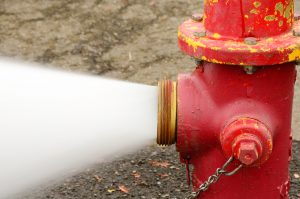 imagine what would happen if in the heat of an emergency, a fireman hooked up the hose to the hydrant and it failed? That’s why municipalities perform regular inspection and maintenance on “public” fire hydrants. imagine what would happen if in the heat of an emergency, a fireman hooked up the hose to the hydrant and it failed? That’s why municipalities perform regular inspection and maintenance on “public” fire hydrants.
However, you may also have fire hydrants installed on your private property which are considered yours to inspect and maintain. The National Fire Protection Association (NFPA) has a standard that is adopted by many village ordinances and outlines the inspection, testing and maintenance requirements that need to be followed.
In other words, to ensure the health of the overall water supply system and the proper functioning of the hydrants located most closely to your business, it is your responsibility to maintain any fire hydrants on your private property.
Recently, the Village of Downers Grove began notifying building owners who have hydrants on their private property of any need for routine inspection, testing and maintenance. The Village is setting an aggressive schedule for ensuring all municipal water mains and hydrants receive the proper testing as outlined by the NFPA standard by September 1. Property owners can contact any commercial fire protection company they want to complete the inspection.
If you need fire hydrant service, Total Fire & Safety can help! We are a trusted, full-service provider of commercial fire protection that has been serving the Village of Downers Grove for more than 30 years.
Our fire hydrant service includes:
- Full inspection
- Any needed repair
- Reporting to DGFD and all third parties (www.theComplianceEngine.com) as directed by the Fire Department
If you are not sure of whether your fire hydrants are in compliance, you can check with the Village of Downers Grove Water Department at 630-434-5460 or the Downers Grove Fire Department at 630-434-5983.
If you would like to schedule your hydrant service today, contact us at 630-960-5060.
Testing ensures the proper flow and flushes debris from the hydrant.
Category: Business Safety, Fire News, Total Fire and Safety Tags: downers grove, downers grove fire, downers grove il, fire hydrant inspection, fire hydrant safety, fire hydrants, fire hydrants il | Comments Off on Downers Grove Businesses: Your Fire Hydrants May Need Inspection
-
May 30, 2018 by Total Fire and Safety
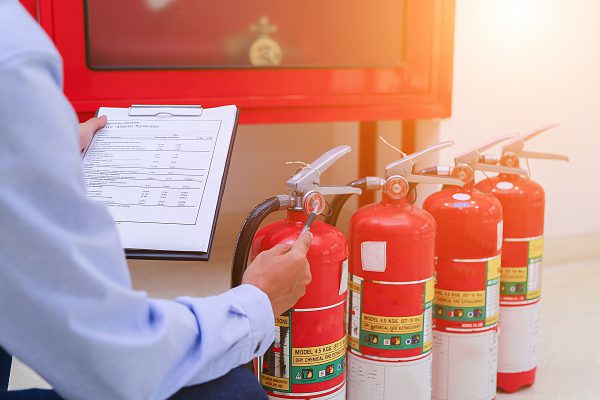
Most companies understand the mandate to have regular fire extinguisher inspections but many wonder why on earth a company could actually fail these inspections. After all, a fire extinguisher is rarely used so how can it need service?
Chances are you see a fire extinguisher every day, but how closely do you look at it? Even one dent in the tank can change the outcome. According to the NFPA, nearly 30 percent of fire extinguishers are not in proper working order. Total Fire and Safety’s twelve-point check can ensure your company’s compliance. However, there are five main reasons why companies fail a fire extinguisher inspection.
1. Unseen Damage– Corrosion or damage can occur over time in hard to see areas of the extinguisher, for example, rust within the tank. That is when a professional steps in and inspects the extinguisher inside and out. TFS will visually examine the extinguisher making sure it is free of dents, rust, or other hazards.
2. Potential Hose Blockage– Debris can clog the hose or deterioration of the O-rings can occur over time, rendering a fire extinguisher useless in an emergency. TFS will remove the hose completely to check for irregularities.
3. Possible Leaks– Whether large or small, a leak will cause the fire extinguisher to be inoperable. Anyone can check the pressure gauge to determine if there is a leak. However, if there is no pressure gauge, you will need a professional. TFS will confirm the compression in the tank.
4. Wear/Fading of Labels– Labels are vital when fighting a fire because they contain instructions on how to use the extinguisher. They also provide important information about the device’s maintenance history, which is needed by inspection professionals. Once your fire extinguisher inspection is complete, the labels will be updated, and an additional certification tag will be attached.
5. Recharging Needed– Once a fire extinguisher is used, even partially, it will need to be recharged immediately. If you fail to recharge the extinguisher, it will fail you in a fire.
Although these are common reasons companies fail fire extinguisher inspections, there are other possible hazards not listed. It is important to stay up-to-date with your fire extinguisher inspections. The NFPA requires inspection every month and maintenance every year by a professional. In addition, a stored pressure extinguisher requires internal maintenance every six years and a hydrostatic test every 12 years.
It takes a minute for a fire to spread and cause irreparable damage to your company—the same amount of time it takes to schedule a fire extinguisher inspection!
Total Fire and Safety can inspect your fire extinguishers to ensure they are unfailingly ready to fight fire at a moment’s notice. We also provide onsite training for your employees, including hands-on practice in the use of a fire extinguisher. Give us a call today at 630.960.5060.
Category: Business Safety, Fire code violation, Fire Equipment Inspections, Fire Extinguishers, Fire Extinguishers, Fire Safety, NFPA Compliance, Total Fire and Safety Tags: equipment, Extinguisher, fire and safety equipment, fire and safety needs, Fire Extinguisher, fire extinguisher inspections, fire safety, safety, Total Fire & Safety, Total Fire and Safety | Comments Off on Why Companies Fail Fire Extinguisher Inspections
-
March 21, 2018 by admin
Join us for the 2018 Fire Safety Symposium
at Total Fire & Safety!
Register below! Space is limited!
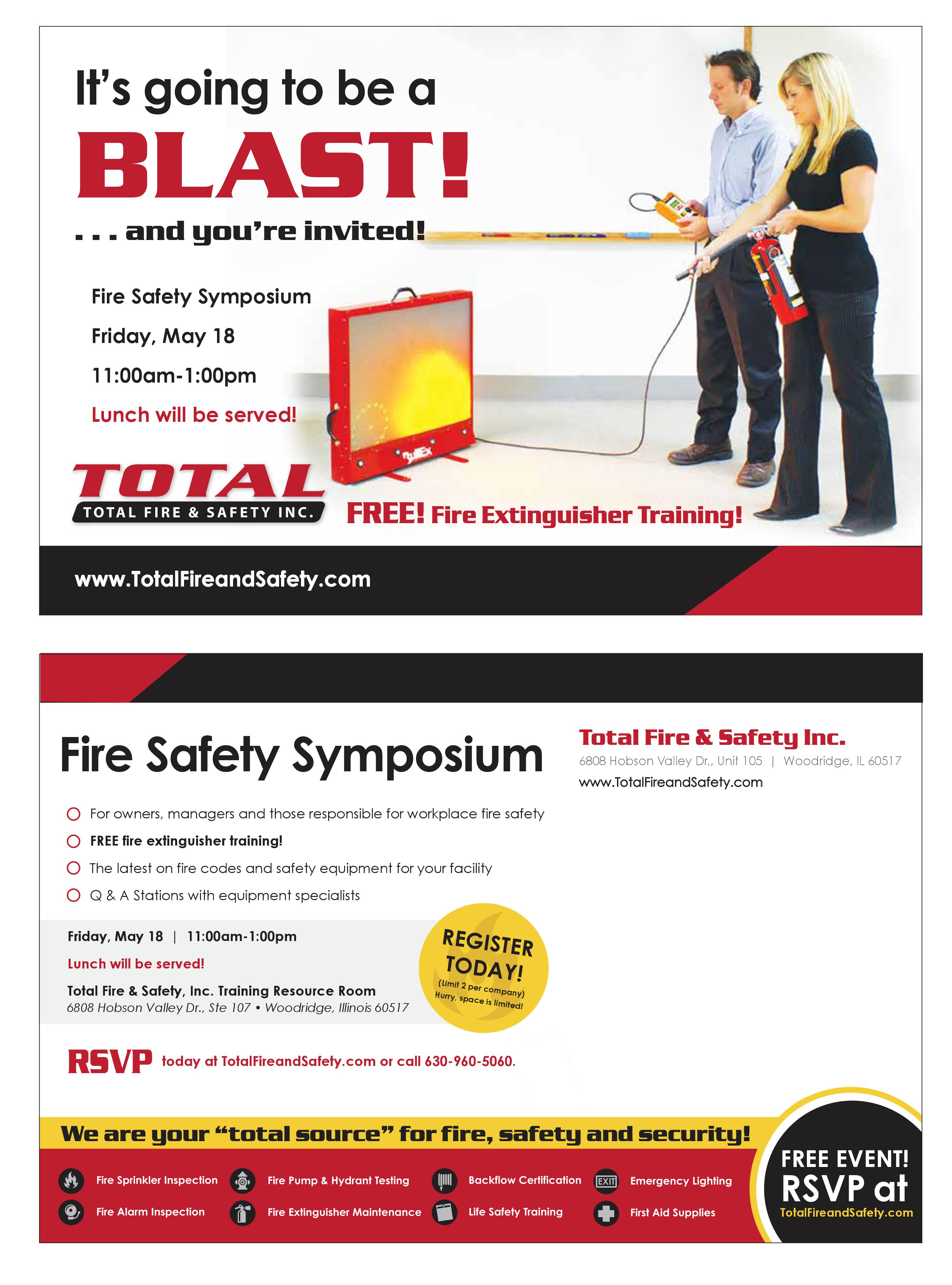
Category: Business Safety, Client Events, Fire Extinguishers, Fire Extinguishers, Fire News, Fire Safety Tags: commercial fire safety, employee training, fire and safety equipment, fire and safety solutions, Fire Extinguisher, fire safety, fireextinguisher, Fireextinguishertraining, Total Fire & Safety, Total Fire and Safety, training | Comments Off on Fire Safety Symposium
-
March 15, 2018 by Total Fire and Safety
 Nobody thinks much about emergency exit lights. But if the power suddenly goes out, smoke fills the room and you can’t see a foot in front of you, relying on the emergency lights may be your only means of escape. Nobody thinks much about emergency exit lights. But if the power suddenly goes out, smoke fills the room and you can’t see a foot in front of you, relying on the emergency lights may be your only means of escape.
Emergency exit lights are essential to safety in any dangerous situation. They can alarm someone in a fire, be the only source of light in the dark, and the key to safely exiting the building. Emergency exit lights are often overlooked and taken for granted, but take note of how many you come across every day. Do you realize how many requirements and regulations go into the installation and maintenance of one exit sign?
There are numerous agencies that govern emergency exit lighting and signs: OSHA (Occupational Safety and Health Administration), NFPA (National Fire Protection Administration, JCAHO (Joint Commission on Accreditation of Healthcare Organizations and the International Building Code and International Fire Code. Above all these agencies, the local authority is responsible for monitoring and enforcing building/fire codes.
According to OSHA, an exit route is defined as a continuous and unobstructed path of exit travel from any point within a workplace to a place of safety. There are three parts to an exit route:
- Exit access-part of the exit route that leads to an exit.
- Exit-part of the exit route that is separated from other areas and provides a safe means of travel to exit discharge.
- Exit discharge-part of the exit route that leads to directly outside or refuge area.
OSHA’s requirements for the lighting of these afore mentioned exit routes is covered under 1910.37(b). It states that each exit route must be sufficiently lighted so an employee with normal vision can see along the exit route and each exit must be clearly visible and marked by a sign reading “EXIT.” Additional information for OSHA requirements can be found at www.osha.gov.
The NFPA guidance for emergency exit lighting and signs can be found in the NFPA 101, Life Safety Code. The NFPA’s Life Safety Code provides information for placement, illumination, and visibility for exit signs.
- Placement of exit sign. Any exit signs must be located so that no point in an exit access area is more than the sign’s viewing distance, or 100 feet from the nearest sign.
- Visibility of exit signs-Every sign must be located and of such size, distinctive color and design that is visible and contrasts from the background of its placement. NFPA also states no decorations, furnishings, or equipment that impairs visibility of a sign shall be permitted. Nothing should be placed near an exit sign that distracts attention and inhibits visibility of an exit sign.
- Illumination of Exit Signs-The NFPA states all exit signs must be illuminated by a reliable light source and legible in normal and emergency exit lighting modes. There are two categories of illumination: external illumination, which comes from outside the exit sign and internal illumination, which comes from a source inside an exit sign.
According to the NFPA, emergency illumination must be provided for a minimum of 1.5 hours in the event of power outage. The emergency lighting must be illuminated not less than an average of one lumen per square foot. The maximum illumination at any point can be 40 times the minimum illumination. All emergency exit lighting must be able to provide lighting automatically when normal light is interrupted.
Many emergency exit lights are now using LED lights. The NFPA states that LED lights are longer lasting, provide better light and are most durable. In emergency situations, LED lights emit sufficient lighting and are most effective when placed properly. They are also most energy efficient, saving the building money.
According to the NFPA requirements for testing, there are three categories of emergency lights: traditional, self-testing, and computer base self-testing. A monthly activation test which involves having the lights illuminate for no less than 30 seconds and an annual test which keeps the lights illuminated for 1.5 hours, simulating a long-term emergency. Records of these test must be maintained for inspection.
Many regulations, codes, and considerations go into the signs and lights you see every day so it is important to have regular maintenance and testing of these lights. Total Fire and Safety has a knowledge team for inspecting emergency exit lighting. With regular maintenance and testing from Total Fire and Safety, you can be assured your emergency exit lighting is up to code and the safety of your employees/tenants is assured. Give us a call today 630-960-5060.
Category: Business Safety, Fire code violation, Fire Equipment Inspections, Fire exits, Fire News, Fire Safety, Health and Safety, LED Lighting, NFPA Compliance, Total Experience, Total Fire and Safety Tags: commercial fire protection, commercial fire safety, emergency exit lights, emergency lighting, fire and safety equipment, fire and safety needs, fire and safety solutions, fire safety in the news, fire safety solution, fire safety training, lifesafety, safety | Comments Off on Are You In the Dark About Emergency Exit Lights?
-
February 13, 2018 by Total Fire and Safety

When a ballistic missile warning sounded in Hawaii recently, few people had an emergency preparedness plan in place. Instead, people were sent into panic. Parents threw their children into sewers, people caught in traffic ran from their cars, some Googled “how to shelter from a nuclear bomb.” We can look at this now in hindsight and think we would have handled it differently. But would we? Whether it’s a ballistic missile, tornado, or a fire it is important to have an emergency preparedness plan.
When a fire occurs in the office, people are likely to react the same way. However, if employees understand what’s going on, what to do, where to go and how to get there, panic will not set in. A fire emergency preparedness plan will help employees feel in control during an emergency and do what needs to be done. .
One way to help employees respond appropriately in an emergency is to remember to REACT:
- R-Remove persons from danger. Know the location of fire exits and that they are not blocked. Steer clear of elevators and equip them with warning signs: in case of fire do not use. They can trap people and must be available to firefighters. Figure out a designated meeting area for employees, safe from danger. Make a procedure in case of entrapment in the building. Assign someone to always keep a list of employees and visitors, so you can begin a roll call once in the safety area.
- E-Ensure doors and windows are closed. Keep doors and windows closed to prevent spreading of the fire.
- A-Activate building alarm. Make sure alarms or a warning signal are working properly and that your employees are familiar with the sound. Most importantly, have regular fire drills.
- C-Call the fire department. Never investigate the fire on your own. Time is minimal for your employees to reach safety quickly.
- T-Treat all fires as dangerous.
A fire preparedness plan also includes having the right equipment and in working order too. Does your place of business have everything it needs to survive a fire? And has it been inspected lately? Know that your facility is up-to-date on the systems it needs to have ready to go in case of a fire:
Don’t forget that the second part of having the right fire equipment is having employees that can operate the equipment safely. Total Fire and Safety offers training courses for employees on all our technologies and equipment. Having employees properly trained improves chances of putting out small fires.
As you can see there are many safety precautions to include in a fire preparedness plan. If your building does not have the proper safety equipment or it is not up to date, there could be catastrophic consequences. Total Fire and Safety always has the well-being of the customer in mind as we complete our inspections. We never give less than 100 precent because you can never be too prepared for a fire. Contact us at: 630.960.5060
Category: Business Safety, Fire code violation, Fire Equipment Inspections, Fire exits, Fire Extinguishers, Fire Extinguishers, Fire Safety, Sprinkler Systems Tags: commercial fire protection, commercial fire safety, commercialfiresprinkler, emergency exit lights, emergency plan, emergency preparedness, employee training, Extinguishertraining, fire safety in the news | Comments Off on Fire in the Office! Do You Have a Fire Emergency Preparedness Plan?
-
January 15, 2018 by Total Fire and Safety
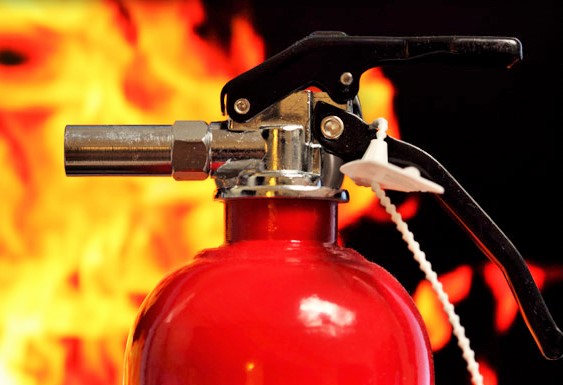
There’s no better way to ring in the new year and make sure your business is ready for any emergency 2018 brings than with proper fire extinguisher service at all of your locations. The National Fire Protection Association (NFPA) states that all portable fire extinguishers be inspected on a monthly basis and maintained by a licensed fire protection company on an annual basis. Yet each year nearly 25,000 fires cost companies over billions of dollars from not only recovery of property and premises but worker’s compensation filings and lawsuits from employees. Sometimes damages could have been reduced if employees had been aware of and actually used the fire extinguishers available.
Properly working fire extinguishers are a first line of defense against fires and can significantly minimize damage until help can arrive. Total Fire and Safety provides a thorough inspection that begins when we walk in the door, and continues throughout the building. Our fire extinguisher service contains our twelve-point check. What are the 12 points?
- Visual examination: We ensure the device is free of dents, rust, corrosion, and other related hazards.
- Test/Maintenance history: We review the test/maintenance history to ensure the internal system is active.
- Pressure Gauge: We check the pressure gauge to confirm the compression in the tank.
- Weight: We make sure the right amount of fluid is inside the tank.
- Discharge hose: We remove it and inspect for irregularities.
- Locking pin: We check for ease of removal in the event of a disaster.
- Handle/Lever: We ensure that the handle/pin will discharge smoothly.
- Clean Extinguisher: We degrease any pertinent areas.
- Inspection certification: We attach a safety flag and service tag to signify when service was completed.
- Extinguisher: We return it to the designated location.
- Mounting Bracket: We secure the extinguisher on its mount correctly.
- Hazard Application: We confirm you have the proper extinguisher type installed for your application.
Hand in hand with having extinguishers is teaching your employees how to use them. That’s why Total Fire & Safety also offers training courses for your employees/tenants so that in the case of an actual emergency, they will not hesitate to reach for the fire extinguisher.
Fire extinguishers are not only legally required but also give employees piece of mind, especially if they know how to use them. Employees appreciate working for a company that has their safety in mind. However, fire extinguisher service is definitely key.
If your fire extinguishers need service or are due for an inspection, please don’t hesitate to contact us at contact us at 630.960.5060.
Category: Fire Equipment Inspections, Fire Extinguishers, Fire Extinguishers, Fire Safety Tags: commercial fire safety, Extinguisher, fire and safety equipment, fire equipment inspection, Fire Extinguisher, fire extinguisher inspection, fire safety, fireextinguisher, Fireextinguishertraining | Comments Off on Is it time for Fire Extinguisher Service?
|

|
|
|
|
|
|

 Facebook
Facebook
 Instagram
Instagram
 LinkedIn
LinkedIn


 If you’re like most companies, you are mandated by OSHA to have a
If you’re like most companies, you are mandated by OSHA to have a  imagine what would happen if in the heat of an emergency, a fireman hooked up the hose to the hydrant and it failed? That’s why municipalities perform regular inspection and maintenance on “public” fire hydrants.
imagine what would happen if in the heat of an emergency, a fireman hooked up the hose to the hydrant and it failed? That’s why municipalities perform regular inspection and maintenance on “public” fire hydrants. 

 Nobody thinks much about
Nobody thinks much about 

